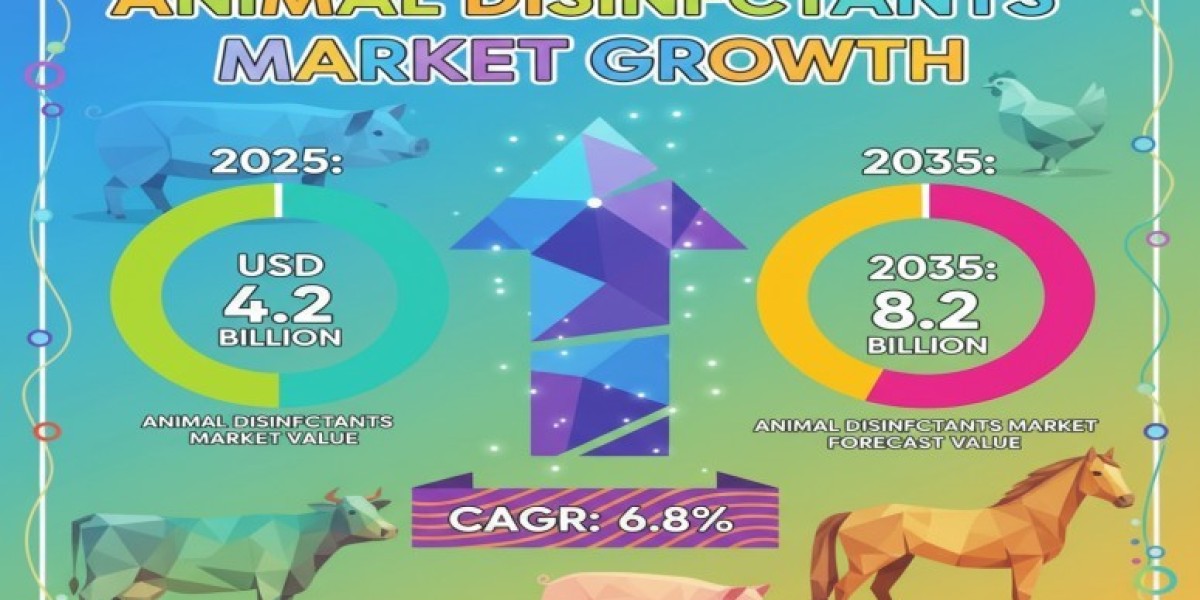The global animal disinfectants market is poised for sustained expansion, forecast to rise from USD 4.2 billion in 2025 to USD 8.2 billion by 2035, reflecting a steady CAGR of 6.8%. This growth underscores a powerful global shift toward enhanced biosecurity measures, disease prevention, and animal welfare, particularly across livestock, poultry, and companion animal care sectors.
Over the past decade, animal hygiene has transitioned from a regulatory obligation to a strategic priority across farms, veterinary facilities, and food processing units. Increasing awareness of zoonotic disease prevention, coupled with government-backed initiatives to improve farm sanitation, continues to drive market demand.
Strong Growth Momentum Across Phases
Between 2021 and 2025, the market demonstrated consistent progress, rising from USD 3.0 billion to USD 4.2 billion. This early growth was largely driven by heightened emphasis on farm-level hygiene and early adoption of biosecurity measures. The next phase, spanning 2026 to 2030, is expected to bring stronger acceleration, growing from USD 4.2 billion to USD 6.3 billion as awareness deepens across livestock and pet care segments.
Segmental Insights: Innovation Anchored in Key Product Categories
Type: Quaternary Compounds Lead with Efficiency and Versatility
Among disinfectant types, quaternary compounds remain the most preferred, accounting for nearly a quarter of the global market share. Known for their broad-spectrum antimicrobial properties, these disinfectants are widely used in farms, equipment sanitization, and veterinary facilities. Manufacturers are introducing enhanced formulations combining quaternary compounds with hydrogen peroxide and iodine to improve efficacy against resistant pathogens.
Veterinary organizations and agricultural extensions worldwide continue to recommend quaternary-based solutions for their long-lasting surface activity, low corrosiveness, and performance in hard water conditions—making them essential for both commercial farms and small-scale operations.
Form: Liquid Disinfectants Dominate the Market
The liquid disinfectants segment, holding 63.4% of market revenue in 2025, continues to outperform due to its ease of use, fast action, and compatibility with automated disinfection systems. Liquids are particularly favored during disease outbreaks, where speed and surface coverage are critical. Manufacturers are increasingly focusing on concentrated liquid formulations to reduce storage costs and improve logistics efficiency, offering flexibility for diverse disinfection needs in livestock and poultry environments.
End User: Livestock Farms Remain the Core Market
Livestock farms represent the largest end-user segment (52.1%), reflecting the ongoing intensification of animal farming and the global demand for meat and dairy products. The growing density of animal populations has amplified the need for routine disinfection protocols covering housing, feeding areas, and transport vehicles. Regulatory mandates, particularly in Europe and North America, have reinforced the use of certified disinfectants to minimize disease risks, thereby supporting consistent demand growth.
Global Market Drivers and Emerging Opportunities
Rising Biosecurity Demands in Livestock and Poultry
As livestock and poultry operations scale globally, the need for biosecurity solutions has become a top priority. Frequent outbreaks of diseases such as avian influenza and foot-and-mouth disease have heightened awareness among producers and regulators. Disinfectants are increasingly viewed as a first line of defense in preventing cross-contamination and maintaining herd health.
Farmers, particularly in Asia-Pacific and Latin America, are adopting routine disinfection practices to safeguard animal productivity and reduce losses. These trends are creating new opportunities for local manufacturers to collaborate with global leaders in expanding distribution networks and customizing formulations to regional biosecurity needs.
Regulatory and Environmental Challenges
While growth prospects are strong, the market faces regulatory complexities and safety compliance challenges. Manufacturers are required to adhere to strict standards set by organizations such as the EPA, EFSA, and WHO, ensuring both product safety and environmental responsibility. The growing emphasis on non-toxic, biodegradable disinfectants has prompted R&D investments across the supply chain. Companies are now re-engineering formulations to meet green chemistry standards without compromising antimicrobial performance.
Sustainable and Natural Formulations: The Next Frontier
A key trend shaping the future of the animal disinfectants market is the shift toward eco-friendly products. Natural formulations derived from essential oils, organic acids, and plant-based compounds are gaining momentum among environmentally conscious producers.
These innovations are not only reducing chemical residues in farming environments but also aligning with the sustainability goals of modern agriculture. Emerging companies are seizing this opportunity by introducing biodegradable, low-toxicity disinfectants targeting both organic and conventional farms.
Technological Advancements in Disease Control
Digital transformation is redefining farm hygiene management. Manufacturers are integrating smart monitoring systems and automated disinfectant dispensers to ensure consistent application and traceability. These innovations support data-driven decision-making in biosecurity management, providing farms with real-time insights into hygiene performance. Advanced formulations with improved contact time and multi-pathogen control further enhance market competitiveness, especially in disease-prone regions.
Competitive Landscape: Established Leaders and Emerging Innovators
- Delaval Inc. and Ecolab lead with comprehensive product lines for farm hygiene and biosecurity.
- Evonik Industries AG, Solvay Group, and Lanxess emphasize sustainable chemistry and low-impact formulations.
- Kemin Industries, Kersia Group, and Neogen Corporation are expanding their portfolios to include pathogen-specific and rapid-action disinfectants.
- Fink Tech GmbH, GEA Group, and Virbac focus on veterinary and farm integration technologies, offering tailored disinfection systems compatible with automated setups.
- Zoetis, a global animal health leader, continues to strengthen its biosecurity ecosystem, combining disinfectant products with broader animal health management solutions.
Get Instant Access for Only $5,000 | Don’t Miss This Exclusive Offer!
https://www.futuremarketinsights.com/reports/sample/rep-gb-25065
Checkout Now to Access Industry Insights:
https://www.futuremarketinsights.com/checkout/25065
About Future Market Insights (FMI)
Future Market Insights, Inc. (ESOMAR certified, recipient of the Stevie Award, and a member of the Greater New York Chamber of Commerce) offers profound insights into the driving factors that are boosting demand in the market. FMI stands as the leading global provider of market intelligence, advisory services, consulting, and events for the Packaging, Food and Beverage, Consumer Technology, Healthcare, Industrial, and Chemicals markets. With a vast team of over 400 analysts worldwide, FMI provides global, regional, and local expertise on diverse domains and industry trends across more than 110 countries.






